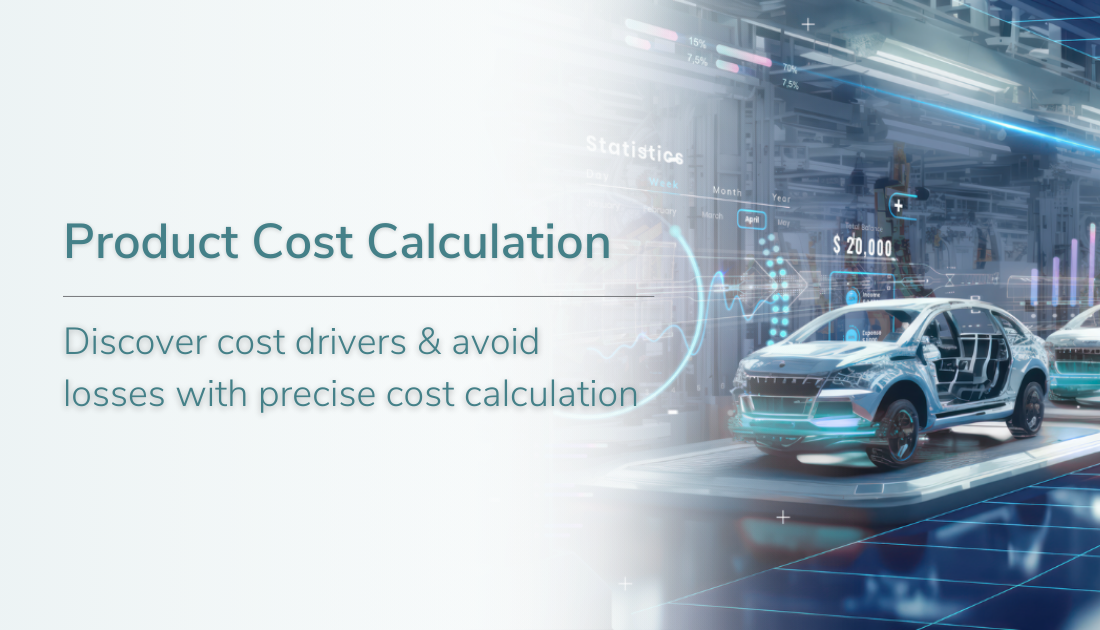Product costing is an essential tool for developing effective pricing strategies and maintaining a competitive edge in manufacturing.
However, the process presents significant challenges—from accurately attributing direct and indirect costs to identifying hidden cost drivers. Mistakes in this area can result in major financial losses over time.
This article will show you how to calculate pricing accurately and mitigate risks effectively.
CONTENT
- What is product costing?
- Three phases of product costing in manufacturing
- Six key methods used in product costing
- Hidden flaws in your product costing
- EPC software: Gaining a competitive edge at every stage of product costing
WHAT IS PRODUCT COSTING?
Product costing, or product cost calculation, is the process of determining all the expenses involved in creating a product. It calculates the costs per unit of manufactured and sold products, which is essential for price-setting and profitability.
The process analyzes both direct costs (individual costs) and indirect costs (overhead costs), offering a comprehensive view of a product’s cost structure.
Product costing is indispensable for price calculation and should be applied to all products, regardless of their lifecycle stage.
THREE PHASES OF PRODUCT COSTING IN MANUFACTURING
Product costing in manufacturing is divided into three key phases:
1. Design Costing
Design costing, also referred to as product design cost estimate, is focused on optimizing costs during the design and development phases. The process identifies cost drivers early on, allowing teams to select the most feasible and market-worthy concepts.
Approximately 80% of a product’s total costs are determined during the development phase; therefore, this stage offers immense cost-saving opportunities. Design costing uncovers potential savings early on by analyzing component choices and manufacturing methods.
2. Quotation Costing
Quotation costing occurs when a company needs to issue a pricing proposal for a specific product or service—for example, in response to inquiries from potential clients.
The goal of this calculation is to determine a competitive price tailored to the needs of specific customers or customer groups.
Good to know
Both design costing and quotation costing are components of preliminary costing.
3. Purchased Parts Price Analysis
The purchased parts price analysis is used in procurement to meticulously examine the cost structure of third-party components.
The goal is to evaluate the transparency and fairness of supplier pricing and identify opportunities to achieve lower costs. This process utilizes both internal and external benchmark data to analyze suppliers' cost structures and define strategies for cost reduction.
SIX KEY METHODS USED IN PRODUCT COSTING
There are various methods for product costing, and the most suitable for controlling costs depends on several factors.
Manufacturing companies often use different costing models than trading companies. Processes can vary between companies managing diverse product portfolios and those focused on mass-producing a single product.
Here is an overview of the key methods for product costing in manufacturing:
ABC Analysis
The ABC analysis categorizes objects such as products, customers, or projects into three groups (A, B, and C), based on their importance. This method helps to understand the impact of objects on costs or success and to set priorities.
Originally developed for inventory management, this method also has applications in controlling, marketing, and procurement. In marketing, for example, the ABC analysis helps classify customers based on their contribution to company success.
Design-to-Cost (DTC)
Design-to-cost sets strict cost targets at the initial stage of a product’s development.
By embedding these targets into the process, DTC ensures that every design and production decision aligns with cost objectives.
The product design cost estimate, carried out by the development department, continuously tracks whether the defined goals are being met. DTC helps manufacturers reduce development efforts, accelerate time to market, and avoid costly rework.
Target Costing
Target-costing is closely related to design-to-cost but focuses more on setting and controlling cost targets rather than on the development process itself.
Target-costing works backward from the market price to determine the target costs and the maximum allowable production costs for a product.
Functional Cost Analysis
Functional cost analysis determines which functions of a product are truly essential.
The process begins by defining the functions that the product must fulfill. These include primary functions, such as a pen’s ability to write, which are absolutely necessary. Secondary functions, such as portability or reusability, are desirable features but not essential for the product to perform its main purpose.
This analysis identifies ways to reduce costs without compromising the product’s quality or functionality.
Make-or-Buy Analysis
A make-or-buy analysis examines whether a company should manufacture a product or provide a service in-house (make), or outsource it (buy). This requires a thorough comparison between the costs and benefits associated with each option.
The analysis is often carried out as part of the controlling process and serves as a foundation for strategic decisions within the company.
Activity-Based Costing
Traditional product costing estimates the cost per production unit by roughly allocating indirect costs as a percentage of direct costs.
This approach is often based on volume-related metrics, such as labor or machine hours. It assumes a correlation between overhead costs and production volume, which does not always reflect reality.
On the other hand, activity-based costing focuses on the specific activities required to produce a product.
It views a business as a collection of activities. Products require activities to be carried out, and these activities, in turn, consume resources.
By concentrating on the resource consumption of these activities, this method provides a more accurate view of overhead (indirect) costs.
HIDDEN FLAWS IN YOUR PRODUCT COSTING
Product costing is a complex and demanding process that requires the use of various methods and the collaboration of many stakeholders. The main departments involved are:
- Development
- Procurement
- Sales
- Controlling
- Management
Coordinating these departments is crucial, as misaligned strategies can significantly harm a company’s competitiveness.
Departments often rely on their own methods and IT systems tailored to their specific objectives. However, this approach results in siloed data, inefficient processes, and poor integration into the overall costing framework.
Enterprise Product Costing (EPC) considers every part of an organization to streamline costing processes and manage costs effectively.
By using a unified data foundation, standardized costing methods, and integrated systems, EPC eliminates fragmentation. This not only enhances efficiency but also enables clear and consistent cost control, supporting a lifecycle perspective.
EPC-SOFTWARE: GAINING A COMPETITIVE EDGE AT EVERY STAGE OF PRODUCT COSTING
An EPC solution effectively addresses challenges during every phase of product costing.
EPC in Product Design Cost Estimates
Decisions made during product development have a significant and direct impact on a product’s cost structure. However, accurately predicting final costs at this stage is challenging, as many influencing factors remain unknown. Additionally, developers and designers tend to focus on technical aspects and often lack training in cost calculations.
EPC software provides engineers with quick and intuitive insights into how their decisions—such as selecting specific materials—affect product costs. If target costs are stored in the system, designers can identify and account for potential savings early in the process.
The system enables users to perform rough calculations or straightforward cost estimates without relying on complex methods. Specialized expertise in cost calculation is thus not required. With integrated ABC analysis, the software identifies which components of the bill of materials hold the highest costs.
EPC in Quotation Costing
Maintaining a competitive edge in manufacturing heavily depends on how quickly and accurately quotations can be prepared.
Manual processes in quotation costing are often time-consuming and prone to errors. An EPC solution eliminates these inefficiencies by automatically transferring data into external templates, such as OEM-specific formats.
EPC systems ensure that all cost-relevant data is consolidated with greater precision. This significantly speeds up the costing process, saving time and resources for in-depth analyses based on precise and transparent calculations.
EPC in Procurement and Purchased Part Cost Analysis
This stage of product cost calculation offers significant cost-saving opportunities.
Departments such as development, procurement, and cost engineering play a crucial role in shaping a product’s cost structure—and, ultimately, its profitability—due to the high volume of purchased components.
To secure the best price for these components, understanding suppliers’ cost structures is essential. However, analyzing these structures and identifying optimization potential is becoming increasingly complex.
FACTON EPC Should Costing leverages benchmark data and advanced features to calculate purchased part costs faster, more easily, and with greater precision.
Should Costing’s software provides companies with a powerful tool for supplier negotiations. By breaking down cost structures in detail, companies can rely on solid data to carefully evaluate quoted prices.
This transparency not only leads to better outcomes for both parties but also fosters stronger collaboration with suppliers.
Leverage FACTON EPC for precise and transparent product costing.
Talk to our experts!




